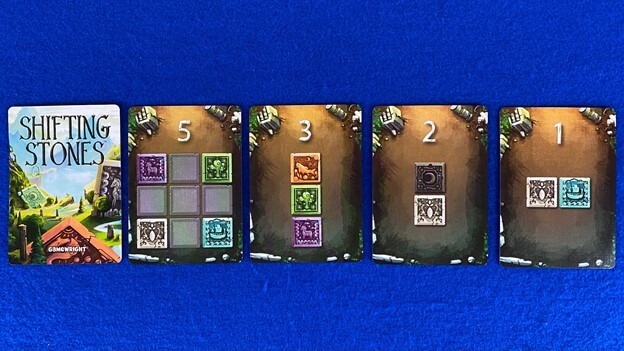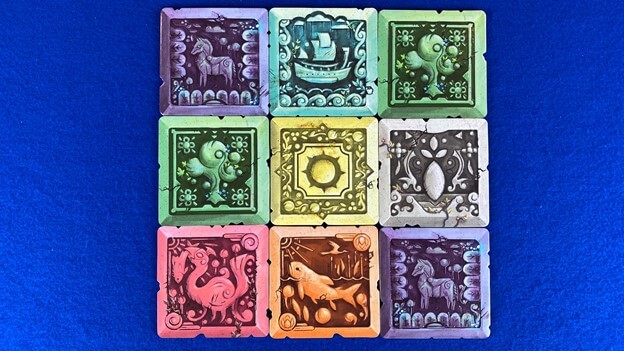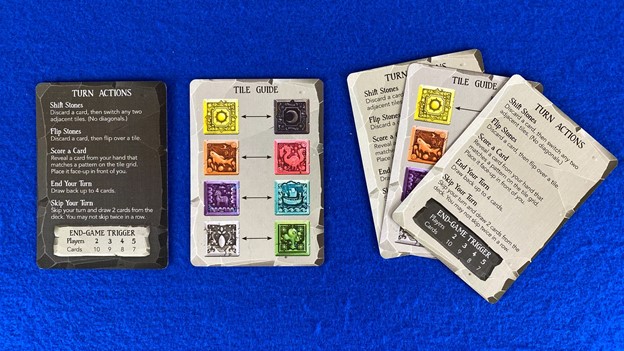
OBJECTIVE OF SHIFTING STONES: End the game with the highest score
NUMBER OF PLAYERS: 1 – 5 Players
CONTENTS: 72 Pattern Cards, 9 Stone Tiles, 5 Reference Cards
TYPE OF GAME: Board Game
AUDIENCE: Kids, Adults
INTRODUCTION OF SHIFTING STONES
Shifting Stones is a pattern building puzzle game published by Gamewright in 2020. In this game, players shift and flip tile stones in order to form patterns. If patterns are formed that match the cards in their hand, the cards can be scored for points. Play your cards right and score multiple patterns in a single turn.
CONTENTS
Shifting Stones has 72 unique pattern cards. These cards can be used to shift and flip stones, or they can be used to score points. Players can potentially earn 1, 2, 3, or 5 points depending on the card.

The 9 Stone tiles are the main focal point of the game. These tiles are flipped and shifted in order to match patterns on the playing cards. Each tile is double sided.

There are also 5 reference cards that detail what a player can do on their turn as well as what each Stone tile contains.

SETUP
Shuffle the Stone tile cards and lay them down to form a 3×3 grid. Make sure they are all oriented the same way.
Shuffle the Pattern cards and deal four to each player face down. Players may look at their hand, but they should not show their cards to their opponents. Place the rest of the Pattern cards face down as a draw pile at the top of Stone tile layout. A discard pile will form directly beside it.
Each player should also have a reference card. Make sure one of the players receives the dark reference card. This card denotes who is player one.
The grid must be oriented in the same direction for players to compare to their Pattern cards. The top of the grid, established by the placement of the draw and discard piles, is the top for all of the players regardless of where they sit.

THE PLAY
The player with the dark reference card goes first. On a player’s turn, they may choose to complete a variety of actions. When discarding to perform some of the actions, the card should be placed face up on the discard pile.
SHIFT STONES
Discard one card in order to shift one Stone tile with another. The two cards must be adjacent to each other. A diagonal shift is not allowed. Pick the two cards up and switch their positions.
FLIP STONES
A player can discard one card to flip a single Stone tile from one side to another. Make sure the tile keeps its orientation.
SCORE A CARD
If a player has a card with a pattern that is formed by the current placement of the Stone tiles, they may score the card. The player scoring the card should place it face up on the table near them. Scored cards should remain visible by all of the players at the table.
END YOUR TURN
When a player is finished with their turn, they end it by drawing back up to a four card hand.
SKIP YOUR TURN
Rather than shift, flip, or score, a player can choose to skip their turn and draw 2 cards from the draw pile. This will give the player a 6 card hand. If the player does this, they end their turn immediately after drawing. A player is not allowed to do this two turns in a row.
Continue playing until the end-game is triggered.
SCORING
Each card has a pattern and a point value. Once a player has scored a Pattern card, that card is placed face up near the player. That card cannot be scored more than once. A card that is discarded cannot be scored. A card is only worth points when it is placed face up on the table.
In order to score a pattern card, the tiles in the grid must match the color and pattern of the tiles on the Pattern card. Grey tiles represent any tile. They are used to denote tile placement in the pattern.
The player who collects the most 1 point cards earns a 3 point bonus. If more than one player ties for most 1 point cards collected, each player earns the 3 point bonus.
WINNING
The end of the game is triggered when a player has obtained a number of cards determined by the number of players in the game.
2 players = 10 cards
3 players = 9 cards
4 players = 8 cards
5 players = 7 cards
Once a player has obtained the number of cards needed to trigger the end game, each player remaining in the turn order gets one more turn. This occurs so that all of the players get the same number of turns. Once play returns to the player with the dark reference card, the game ends.
The player with the most points at the end of the game is the winner.
If a tie occurs, the victory is shared.
- TRIPLE SNAKES - February 15, 2021